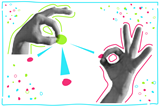Putting students in charge of their learning can improve low to medium performers’ engagement and progress. Here’s how it could work in your classroom
Structure is an essential element in teaching and learning. According to the theory of constructivism, students are required to construct their own understanding through experience and reflection. Such a process is facilitated if teaching activities around a particular topic are presented in a logical order that supports students in making the requisite learning steps. Where such structure is lacking, students may come to see chemistry as a jumble of isolated facts that need to be memorised, rather than a coherent discipline made up of interrelated concepts. In this study, Helena van Vorst evaluates ladders of learning (LLs) as a tool for structuring learning content and signposting it to students.

The article presents graphical examples of LLs comprising milestones and elements. Elements are the learning activities that make up each milestone, and are characterised as:
- Introductory (learning new concepts and terms, guided by the teacher);
- Reinforcement (practising concepts collaboratively);
- Evaluation (testing whether students have understood core ideas and can apply them);
- Remedial (completing individual activities, differentiated on the basis of evaluation); and
- Enrichment (transferring new knowledge and skills to other contexts).
The LL developed in this study relates to the Bohr model of the atom, featuring four milestones progressing from Rutherford’s model to the periodic table. The learning materials themselves, examples of which are included in the journal article, were developed in collaboration with ten teachers from secondary schools in Germany. Each student received a poster of the LL. Over a series of lessons, they progressed up the learning ladder, completing self-evaluation tasks and undertaking differentiated activities at appropriate stages.
Included in the analysis was data from 524 students, split between an intervention group who used the LL and a control group who were taught using traditional approaches. Students taught using the LL significantly outperformed those in the control group in post-testing, while analysis of questionnaire data showed students’ interest in chemistry decreased in the control group but remained unchanged in the intervention group.
Students in the intervention group were interviewed about their prior experiences and their perceptions of the pros and cons of LLs. They generally reported that their previous lessons tended to encourage rote-learning, including many facts and formulas that needed to be memorised. Overall, they were very positive about the use of LLs, with medium and low performers expressing the view that the approach benefited them thanks to the opportunities for self-evaluation and differentiated learning activities. However, high achievers were less positive, expressing views that indicate they would prefer to move through the topic at a more natural pace for them. Work on the individual activities targeted at these learners could improve their experience.
Teaching tips
A key challenge for an early career teacher is developing the confidence to hand responsibility for learning over to students, adopting the role of ‘guide on the side’ rather than ‘sage on the stage’. Although teacher-led approaches can be effective, they can be exhausting and are less likely to develop the skills required for independent learning. LLs provide a clear and coherent structure for students to monitor their own progress through a sequence of learning tasks that ensure they are able to fulfil their potential on a particular topic.
- Select a topic for which a range of differentiated resources are already available.
- Design a LL that incorporates these activities and self-evaluation tests (eg MCQs derived from exams) and direct students towards the most appropriate follow-up tasks for their achievement level.
- Share the LL with students and explain that they will be managing their progress through the topic with your input where required.
- Take a proactive role in monitoring students’ progress to ensure they stay on task and complete the activities – there is scope for students to drift if time isn’t managed effectively.
Given the work involved, it might be worthwhile to work on this as a team within a department or across partner schools, especially if a significant number of new resources need to be developed. LLs might be particularly effective in structuring learning as part of a flipped classroom approach.
Given the work involved, it might be worthwhile to work on this as a team within a department or across partner schools, especially if a significant number of new resources need to be developed. LLs might be particularly effective in structuring learning as part of a flipped classroom approach (rsc.li/2JcEG6y).
David Read
References
H Van Vorst, Chem. Ed. Res. Pract., 2018, DOI 10.1039/c8rp00078f














No comments yet